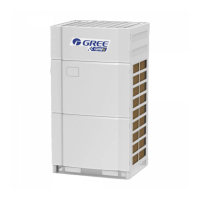GMV DC Inverter VRF
32
3.4.4 Refrigerant Pipe Insulation
(1) Insulation Material Selection
1) Insulation materials should be made of materials that can withstand pipeline temperature:
For heat pump unit, liquid pipe should bear 70
℃
or above, and gas pipe should bear
120
℃
or above. For cooling only unit, both liquid pipe and gas pipe should bear 70
℃
or
above.
Example: heat-resistant polyethylene foam (resistant to 120
℃
or more); foamed
polyethylene (resistant to 100
℃
or more).
2) When the diameter of the copper pipe is more than or equal to Φ15.9mm, the wall
thickness of the insulation material is no less than 20mm; when the diameter of the
copper pipe is less than 15.9mm, the wall thickness of the insulation material is no less
than 15mm.
(2) Pipeline Wrapping
1) To avoid condensate or water leakage on connecting pipe, the gas pipe and liquid pipe
must be wrapped with thermal insulating material and adhesive pipe for insulation from
the air.
2) Joints at indoor and outdoor units should be wrapped with insulating material and leave
no clearance between pipe and wall. See Fig. 3.4.8.
Fig. 3.4.8
3) When wrapping the tape, the later circle should cover half of the former one. Don't wrap
the tape so tightly, otherwise the insulation effect will be weakened.
4) After wrapping the pipe, adopt sealing material to completely fill the hole.
3.4.5 Support and Protection of Pipelines
(1) The suspended connection pipes should be supported, and the distance between the
supports should not exceed 1m.
(2) The outdoor pipeline should be protected against accidental damage. If the pipeline exceeds
1m, a gusset plate must be added to the pipeline.
3.5 Static Pressure Ventilation Pipe Installation
Refer to this section when a static pressure ventilation duct should be installed for the unit.
3.5.1 Preparation of Static Pressure Ventilation Pipe Installation
(1) Install the outdoor unit well.
(2) The steel plate ventilation pipe is designed according to the unit and engineering
requirements, and is installed well in accordance with the engineering regulations.

